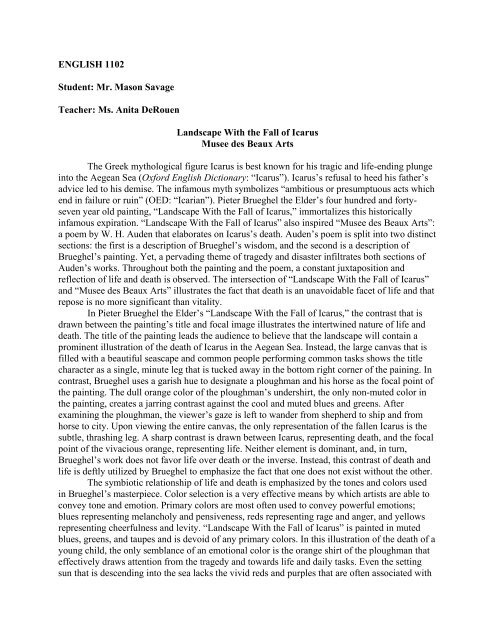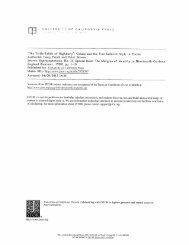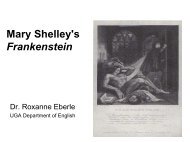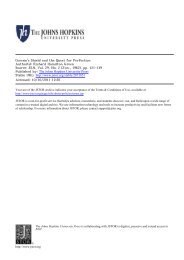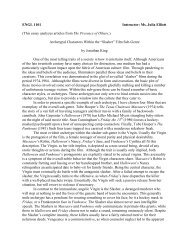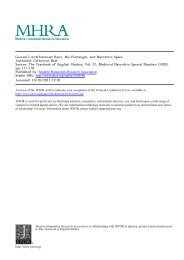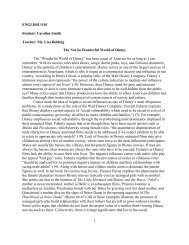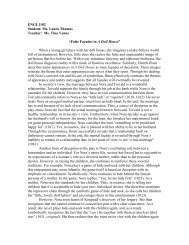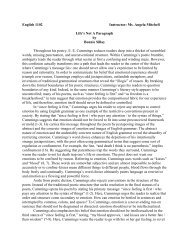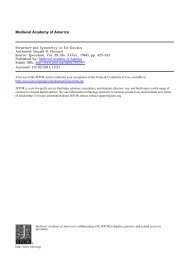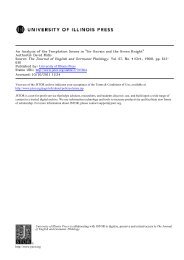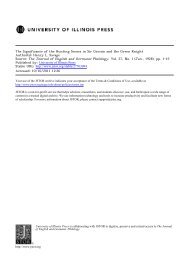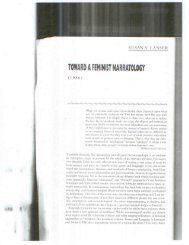Landscape With the Fall of Icarus
Landscape With the Fall of Icarus
Landscape With the Fall of Icarus
You also want an ePaper? Increase the reach of your titles
YUMPU automatically turns print PDFs into web optimized ePapers that Google loves.
ENGLISH 1102<br />
Student: Mr. Mason Savage<br />
Teacher: Ms. Anita DeRouen<br />
<strong>Landscape</strong> <strong>With</strong> <strong>the</strong> <strong>Fall</strong> <strong>of</strong> <strong>Icarus</strong><br />
Musee des Beaux Arts<br />
The Greek mythological figure <strong>Icarus</strong> is best known for his tragic and life-ending plunge<br />
into <strong>the</strong> Aegean Sea (Oxford English Dictionary: “<strong>Icarus</strong>”). <strong>Icarus</strong>’s refusal to heed his fa<strong>the</strong>r’s<br />
advice led to his demise. The infamous myth symbolizes “ambitious or presumptuous acts which<br />
end in failure or ruin” (OED: “Icarian”). Pieter Brueghel <strong>the</strong> Elder’s four hundred and fortyseven<br />
year old painting, “<strong>Landscape</strong> <strong>With</strong> <strong>the</strong> <strong>Fall</strong> <strong>of</strong> <strong>Icarus</strong>,” immortalizes this historically<br />
infamous expiration. “<strong>Landscape</strong> <strong>With</strong> <strong>the</strong> <strong>Fall</strong> <strong>of</strong> <strong>Icarus</strong>” also inspired “Musee des Beaux Arts”:<br />
a poem by W. H. Auden that elaborates on <strong>Icarus</strong>’s death. Auden’s poem is split into two distinct<br />
sections: <strong>the</strong> first is a description <strong>of</strong> Brueghel’s wisdom, and <strong>the</strong> second is a description <strong>of</strong><br />
Brueghel’s painting. Yet, a pervading <strong>the</strong>me <strong>of</strong> tragedy and disaster infiltrates both sections <strong>of</strong><br />
Auden’s works. Throughout both <strong>the</strong> painting and <strong>the</strong> poem, a constant juxtaposition and<br />
reflection <strong>of</strong> life and death is observed. The intersection <strong>of</strong> “<strong>Landscape</strong> <strong>With</strong> <strong>the</strong> <strong>Fall</strong> <strong>of</strong> <strong>Icarus</strong>”<br />
and “Musee des Beaux Arts” illustrates <strong>the</strong> fact that death is an unavoidable facet <strong>of</strong> life and that<br />
repose is no more significant than vitality.<br />
In Pieter Brueghel <strong>the</strong> Elder’s “<strong>Landscape</strong> <strong>With</strong> <strong>the</strong> <strong>Fall</strong> <strong>of</strong> <strong>Icarus</strong>,” <strong>the</strong> contrast that is<br />
drawn between <strong>the</strong> painting’s title and focal image illustrates <strong>the</strong> intertwined nature <strong>of</strong> life and<br />
death. The title <strong>of</strong> <strong>the</strong> painting leads <strong>the</strong> audience to believe that <strong>the</strong> landscape will contain a<br />
prominent illustration <strong>of</strong> <strong>the</strong> death <strong>of</strong> <strong>Icarus</strong> in <strong>the</strong> Aegean Sea. Instead, <strong>the</strong> large canvas that is<br />
filled with a beautiful seascape and common people performing common tasks shows <strong>the</strong> title<br />
character as a single, minute leg that is tucked away in <strong>the</strong> bottom right corner <strong>of</strong> <strong>the</strong> paining. In<br />
contrast, Brueghel uses a garish hue to designate a ploughman and his horse as <strong>the</strong> focal point <strong>of</strong><br />
<strong>the</strong> painting. The dull orange color <strong>of</strong> <strong>the</strong> ploughman’s undershirt, <strong>the</strong> only non-muted color in<br />
<strong>the</strong> painting, creates a jarring contrast against <strong>the</strong> cool and muted blues and greens. After<br />
examining <strong>the</strong> ploughman, <strong>the</strong> viewer’s gaze is left to wander from shepherd to ship and from<br />
horse to city. Upon viewing <strong>the</strong> entire canvas, <strong>the</strong> only representation <strong>of</strong> <strong>the</strong> fallen <strong>Icarus</strong> is <strong>the</strong><br />
subtle, thrashing leg. A sharp contrast is drawn between <strong>Icarus</strong>, representing death, and <strong>the</strong> focal<br />
point <strong>of</strong> <strong>the</strong> vivacious orange, representing life. Nei<strong>the</strong>r element is dominant, and, in turn,<br />
Brueghel’s work does not favor life over death or <strong>the</strong> inverse. Instead, this contrast <strong>of</strong> death and<br />
life is deftly utilized by Brueghel to emphasize <strong>the</strong> fact that one does not exist without <strong>the</strong> o<strong>the</strong>r.<br />
The symbiotic relationship <strong>of</strong> life and death is emphasized by <strong>the</strong> tones and colors used<br />
in Brueghel’s masterpiece. Color selection is a very effective means by which artists are able to<br />
convey tone and emotion. Primary colors are most <strong>of</strong>ten used to convey powerful emotions;<br />
blues representing melancholy and pensiveness, reds representing rage and anger, and yellows<br />
representing cheerfulness and levity. “<strong>Landscape</strong> <strong>With</strong> <strong>the</strong> <strong>Fall</strong> <strong>of</strong> <strong>Icarus</strong>” is painted in muted<br />
blues, greens, and taupes and is devoid <strong>of</strong> any primary colors. In this illustration <strong>of</strong> <strong>the</strong> death <strong>of</strong> a<br />
young child, <strong>the</strong> only semblance <strong>of</strong> an emotional color is <strong>the</strong> orange shirt <strong>of</strong> <strong>the</strong> ploughman that<br />
effectively draws attention from <strong>the</strong> tragedy and towards life and daily tasks. Even <strong>the</strong> setting<br />
sun that is descending into <strong>the</strong> sea lacks <strong>the</strong> vivid reds and purples that are <strong>of</strong>ten associated with
sunsets. Instead, this sun barely reflects its dull orangish-yellow glow onto <strong>the</strong> greenish-blue sea.<br />
The bland sunset, symbolically representative <strong>of</strong> death or an ending, removes <strong>the</strong> tragic emotions<br />
from <strong>Icarus</strong>’s demise by placidly illuminating his death in indifferent and emotionless tones.<br />
Brueghel’s emotionless illustration <strong>of</strong> living and dying glorifies nei<strong>the</strong>r life nor death, but ra<strong>the</strong>r<br />
fur<strong>the</strong>r established <strong>the</strong> two as equal inverses through his deliberate use <strong>of</strong> color.<br />
Brueghel’s usage <strong>of</strong> color is mentioned only twice in Auden’s literary work. Auden notes<br />
Brueghel’s brushwork <strong>of</strong> <strong>the</strong> “green/water” and <strong>Icarus</strong>’s “white legs” (19-20, 19). In describing<br />
muted colors instead <strong>of</strong> <strong>the</strong> ploughman’s orange shirt, Auden focuses <strong>the</strong> audience’s attention <strong>of</strong><br />
<strong>the</strong> lack <strong>of</strong> emotional undertones in <strong>the</strong> painting. The colors that Auden draws attention to, green<br />
waters and <strong>Icarus</strong>’s white legs, carry an important symbolic value. Green and white, which<br />
represent inexperience and innocence respectively, illustrate <strong>Icarus</strong>’s innocent life and death.<br />
This description works in direct conjunction with <strong>the</strong> mention <strong>of</strong> <strong>the</strong> “torturer’s horse” and its<br />
“innocent behind” (13, 14). Both <strong>the</strong>se innocent creatures - <strong>Icarus</strong> and <strong>the</strong> torturer’s horse - are<br />
exposed to tragedy and death: <strong>Icarus</strong>’s death resulting from his own inexperience and <strong>the</strong> horse’s<br />
exposure to tragedy resulting from his owner’s actions. By illustrating <strong>the</strong> fact that even <strong>the</strong> most<br />
innocent creatures are plagued by death and tragedy, Auden illuminates <strong>the</strong> fact that death is<br />
unavoidable for every living creature; <strong>the</strong>reby, revealing <strong>the</strong> inseparable nature <strong>of</strong> life and death.<br />
Auden’s vocabulary and descriptions fur<strong>the</strong>r emphasize <strong>the</strong> equivalent weight that life<br />
and death possess. Throughout <strong>the</strong> poem, Auden describes <strong>Icarus</strong>’s death through emotionless<br />
and detached words. <strong>Icarus</strong>’s fall, as seen through <strong>the</strong> eyes <strong>of</strong> <strong>the</strong> ploughman, is described as<br />
“not an important failure” (18). The ship that is sailing away from <strong>Icarus</strong> sees <strong>the</strong> same event as<br />
“something amazing, a boy falling out <strong>of</strong> <strong>the</strong> sky” (21). Descriptions <strong>of</strong> <strong>the</strong> o<strong>the</strong>r characters’<br />
actions parallel <strong>the</strong> dispassionate description <strong>of</strong> <strong>Icarus</strong>’s passing. The activities <strong>of</strong> <strong>the</strong> living are<br />
portrayed as lax and leisurely: “walking / dully,” “reverently, passionately waiting,” “skating<br />
/On a pond,” and “Scratch[ing] its innocent behind” (4-5, 6, 8-9, 14). By portraying both <strong>the</strong><br />
actions <strong>of</strong> <strong>the</strong> living and dying in <strong>the</strong> same detached light, Auden is able to reveal <strong>the</strong> fact that<br />
life holds no greater significance than death and vice versa.<br />
To thoroughly emphasize <strong>the</strong> inextricable essence <strong>of</strong> life and death, both Auden and<br />
Brueghel surround death with life. In Brueghel’s “<strong>Landscape</strong> <strong>With</strong> <strong>the</strong> <strong>Fall</strong> <strong>of</strong> <strong>Icarus</strong>,” <strong>the</strong> dying<br />
<strong>Icarus</strong> is engulfed by life. A ploughman, a shepherd, a fisherman, a hawk, a horse, a city, follage,<br />
six ships, and nineteen sheep engulf life, and are ignorant <strong>of</strong> a dying <strong>Icarus</strong>. The ships, which are<br />
made <strong>of</strong> wood and steel, seem to be more alive than <strong>Icarus</strong> due to <strong>the</strong>ir engorged sails. This same<br />
encircling <strong>the</strong>me is mimicked by Auden in “Musee des Beaux Arts.” Auden opens his poem with<br />
<strong>the</strong> <strong>the</strong>me <strong>of</strong> constant suffering. He <strong>the</strong>n quickly encircles life <strong>of</strong> every sort around <strong>the</strong><br />
everlasting nature <strong>of</strong> suffering:<br />
While someone else is eating or opening a window or just walking / dully along; /<br />
How when <strong>the</strong> aged are reverently, passionately waiting / For <strong>the</strong> miraculous<br />
birth, <strong>the</strong>re always must be / Children who did not specially want it to happen,<br />
skating / On a pond at <strong>the</strong> edge <strong>of</strong> <strong>the</strong> wood/ (4-9).<br />
This pattern is continued into <strong>the</strong> description <strong>of</strong> Brueghel’s painting. In <strong>the</strong> second section <strong>of</strong> his<br />
poem, Auden begins by mentioning “<strong>the</strong> disaster” <strong>of</strong> <strong>Icarus</strong>’s demise (16). <strong>Icarus</strong> is quickly<br />
surrounded by a disinterested ploughman, a sun that “shone / As it had to on <strong>the</strong> white legs,” and<br />
an “expensive[ly] delicate” ship that “had somewhere to get to and sailed calmly on” (18-19, 18,<br />
22). Though life and death are <strong>of</strong>ten thought to be anti<strong>the</strong>ses <strong>of</strong> each o<strong>the</strong>r, <strong>the</strong> strategic
placement <strong>of</strong> vitality next to tragedy in both “<strong>Landscape</strong> <strong>With</strong> <strong>the</strong> <strong>Fall</strong> <strong>of</strong> <strong>Icarus</strong>” and “Muse des<br />
Beaux Arts” reveals <strong>the</strong>ir intertwined nature.<br />
The intersection <strong>of</strong> “<strong>Landscape</strong> <strong>With</strong> <strong>the</strong> <strong>Fall</strong> <strong>of</strong> <strong>Icarus</strong>” and “Muse des Beaux Arts”<br />
reveals <strong>the</strong> equivalent and inseparable nature <strong>of</strong> life and tragedy. Brueghel was able to convey<br />
this message through <strong>the</strong> contrast <strong>of</strong> title character and focal point, his color choice, and <strong>the</strong><br />
juxtaposition <strong>of</strong> lively and tragic images in his painting. Auden reinforced <strong>the</strong> same message<br />
through highlighting Brueghel’s wisdom and significant areas <strong>of</strong> <strong>the</strong> painting in his poem. By<br />
studying <strong>the</strong>se two pieces, one is able to realize that death and life are infinitely intertwined and<br />
are equally significant. In realizing this dualistic nature <strong>of</strong> life and death, one is able to truly<br />
enjoy life by not fearing death.<br />
Works Cited<br />
Auden, W. H. “Muse des Beaux Arts.” 14 July 2005.<br />
.<br />
Brueghel, Pieter. <strong>Landscape</strong> <strong>With</strong> <strong>the</strong> <strong>Fall</strong> Accurst. 1558. Musees Royaux des Beaux-Arts des<br />
Beaux-Arts de Belgique, Brussels<br />
“Icarian.” Oxford English Dictionary. 2005. U. Of Georgia. 29 June 2005.<br />
.<br />
“<strong>Icarus</strong>.” Oxford English Dictionary. 2005. U. Of Georgia. 29 June 2005.<br />
.


